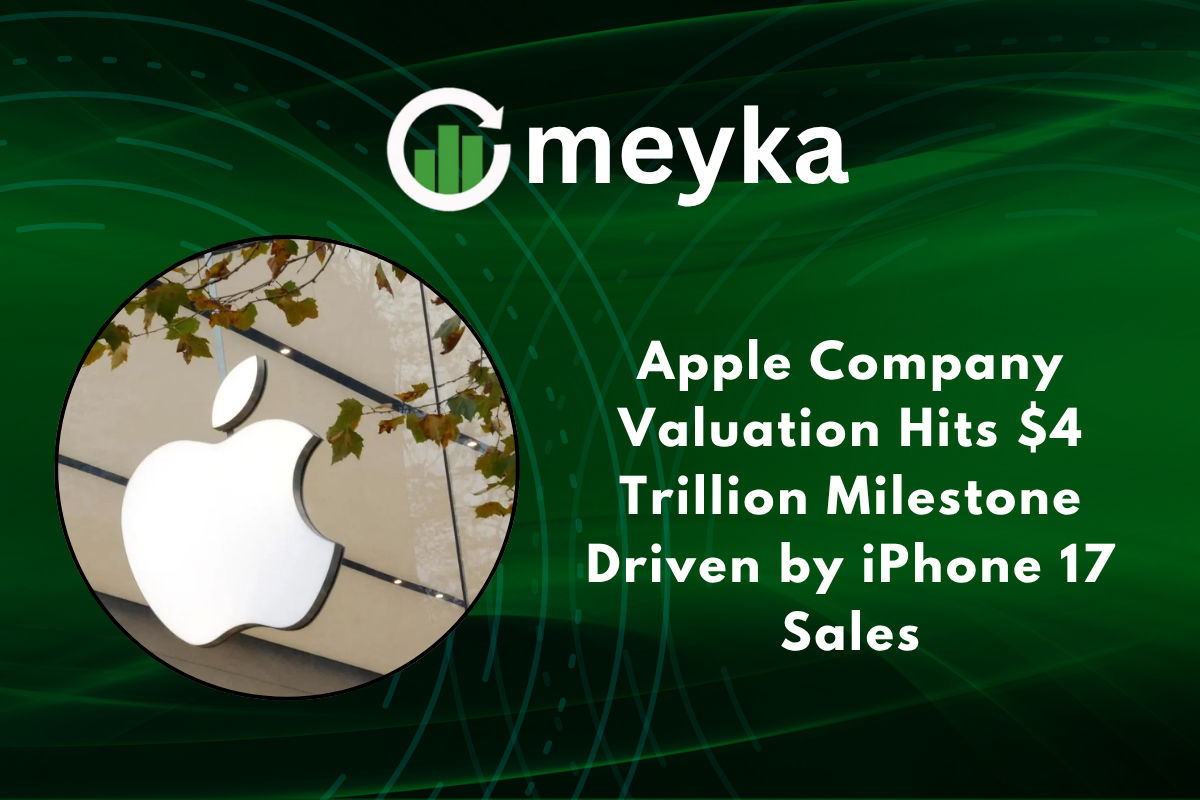Apple Company Valuation Hits $4 Trillion Milestone Driven by iPhone 17 Sales
Apple has briefly crossed the $4 trillion market-value mark after a strong run of iPhone 17 sales and renewed investor confidence. The milestone makes Apple only the third public company ever to touch $4 trillion, joining Nvidia and Microsoft in an elite club. This day marks a major moment for the US tech sector and global markets.
Apple market milestone: what happened?
Apple’s shares (AAPL) spiked early in trading and briefly reached about $269.89, putting its market value at roughly $4.005 trillion before settling slightly lower by the close.
That intraday peak reflected a wave of buying tied to fresh product momentum and easing tariff concerns. Investors said the iPhone cycle has returned and is supporting Apple’s valuation.
Why did Apple hit this level now? The iPhone 17 launch revived demand. Sales in key markets surprised many analysts, and that fed optimism ahead of quarterly results.
Apple and iPhone 17: sales and regions
The iPhone 17 lineup, including the new iPhone Air, has outperformed the previous generation in early sales checks. Research firms showed the iPhone 17 selling about 14% better than the iPhone 16 in the U.S. and China over the launch period.
That stronger sell-through matters because iPhone revenue still drives more than half of Apple’s profit.
Where did demand rise the most? Early strength was seen in the United States and China, two markets that matter most for Apple’s growth. Carrier deals and attractive new models helped push upgrades.
Investor chatter and quick market reactions surfaced widely on social media; for example, Reuters’ live coverage and reaction tweets amplified the story as markets moved. See Reuters’ post here:
Apple and AI: hardware, chips, and new features
Apple’s (AAPL) product cycle is not just about phones. The company has layered Apple Intelligence features into iOS and the iPhone 17 family. These on-device AI tools, and the faster neural engines in recent chips, help Apple keep the user experience competitive while focusing on privacy.
How big a role did AI play in the rally? AI features helped the narrative, but hardware and sales were the clearer drivers for the $4T move. Apple’s Apple Intelligence work keeps investor faith that the company will deliver more AI value across devices and services.
Apple: what investors and analysts are saying
Wall Street reaction was mixed but mostly upbeat. Some analysts said the iPhone cycle and services growth justify a premium multiple. Others warned that Apple (AAPL) still faces a big long-term AI gap compared with cloud and AI-first firms. Markets priced in both the upgrade cycle and hopes for a stronger Apple AI play.
Is investor excitement broad-based? Yes, traders, institutions, and retail investors all took notice. The online investor community and analysts quickly posted reactions and notes. For example, an investor post highlighted the fast market move after the iPhone data. See a sample investor reaction:
Apple vs. peers: market context
Apple (AAPL) joining the $4 trillion club matters for market structure. It sits alongside Nvidia and Microsoft in value terms, companies that have benefited heavily from AI demand. Apple’s climb adds to a narrow group of mega-cap leaders that are now shaping index performance and investor flows. Bloomberg and other outlets noted the push in major indices and the impact on global market sentiment.
Does Apple now lead tech? Not exactly. Apple’s resurgence is powerful, but other firms, especially Nvidia, continue to lead in AI-specific segments. Apple’s strength is its integrated hardware + services ecosystem and the size of its installed base.
Apple risks and what to watch next
Apple still faces risks. Tariff pressures, supply-chain shifts, and the challenge of scaling AI features are all real. The company has been cautious in public AI messaging, and some analysts urge faster, clearer moves on generative AI and strategic partnerships.
Tim Cook has signaled openness to acquisitions and partnerships as Apple builds its AI strategy.
What should shareholders track? Watch the upcoming quarterly report, iPhone shipment trends, Services revenue growth, and any fresh AI product announcements. Execution on these items will determine whether the $4T level is sustainable.
Apple: the global picture and news coverage
Global media covered the milestone quickly. Outlets in the U.S., Europe, and Asia emphasized how iPhone demand and easing tariff worries pushed the stock higher. International feeds and broadcasters posted breaking updates and investor commentary across platforms. For global context and live coverage, see this international report:
Is this headline likely to drive policy or regulation? Large market moves can draw regulatory attention over competition and market concentration, but immediate policy shifts are unlikely. The bigger influence is on investor flows and index composition.
Multimedia: see the coverage and keynote highlights
If you want a quick video overview, CNBC’s short report covers Apple’s market run and the iPhone 17 impact well: Apple nears $4 trillion valuation (CNBC clip). Watching the clip helps clarify the market moves and the analyst takes in a few minutes.
What this milestone means for owners and users
For shareholders, the $4T moment is a sign of regained momentum. For customers, it shows Apple’s product cycle is still strong. For competitors, it’s a reminder that Apple’s scale and services give it power to fund AI work and hardware investment for years to come.
Quick takeaways
- Apple’s market value briefly topped $4 trillion on strong early sales of the iPhone 17.
- iPhone 17 demand outpaced the last cycle in key markets like the U.S. and China.
- Apple Intelligence and chip upgrades add long-term hope, but execution matters.
- Investor focus now turns to the quarter ahead: revenue, services growth, and any new AI announcements.
Conclusion
Apple’s brief climb to $4 trillion shows how a strong product cycle can change market sentiment quickly. The iPhone 17 launch revived demand and lifted investor confidence. The next test is execution: quarterly results, service growth, and clear steps on Apple’s AI roadmap will decide if this valuation holds. As Apple celebrates the milestone, the market will closely watch what comes next.
FAQ’S
Apple hit a $4 trillion valuation due to strong iPhone 17 sales, growing demand in the U.S. and China, and investor confidence in its AI-powered products.
Apple’s market capitalization briefly surpassed $4 trillion, making it one of the most valuable companies in the world, alongside Nvidia and Microsoft.
The iPhone 17 series drove record demand, outperforming previous models and boosting Apple’s revenue across major markets, especially in Asia and North America.
Yes. Apple has integrated Apple Intelligence across its devices, enhancing Siri, camera features, and user privacy while competing with AI innovations from rivals.
Analysts say sustainability depends on continued iPhone demand, AI innovation, and strong quarterly earnings to maintain investor trust and growth momentum.
Disclaimer
The content shared by Meyka AI PTY LTD is solely for research and informational purposes. Meyka is not a financial advisory service, and the information provided should not be considered investment or trading advice.






